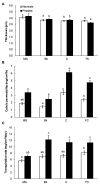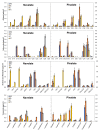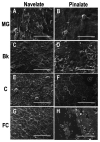Abscisic Acid Deficiency Alters Epicuticular Wax Metabolism and Morphology That Leads to Increased Cuticle Permeability During Sweet Orange (Citrus sinensis) Fruit Ripening
- PMID: 33362823
- PMCID: PMC7755607
- DOI: 10.3389/fpls.2020.594184
Abscisic Acid Deficiency Alters Epicuticular Wax Metabolism and Morphology That Leads to Increased Cuticle Permeability During Sweet Orange (Citrus sinensis) Fruit Ripening
Abstract
Citrus fruit ripening is coupled with the synthesis and deposition of epicuticular waxes, which reduces water loss during fruit postharvest storage. Although abscisic acid (ABA) is a major regulator of citrus fruit ripening, whether ABA mediates epicuticular wax formation during this process remains poorly understood. We investigated the implication of ABA in cuticle properties and epicuticular wax metabolism, composition, and morphology by comparing the Navelate orange [Citrus sinensis (L.) Osbeck] and its ABA biosynthesis-impaired mutant Pinalate in four ripening stages. ABA deficiency had minor effects on cuticle thickness and epicuticular wax load, but correlated with cuticle permeability. ABA content aligned with mostly fatty acids accumulation in both cultivars, and also with specific alkane, terpenoid, and aldehyde constituents in the parental fruit. In turn, cuticle permeability correlated with the fatty acid profile during fruit ripening in the Navelate and Pinalate, and with primary alcohols, terpenoids, and aldehydes, but only in the mutant fruit. Low ABA levels increased the susceptibility of waxes to crack and were lost from the epicuticular layer. The RNA-seq analysis highlighted the differential regulation of a list of 87 cuticle-related genes between genotypes and ripening stages. Changes in the gene expression of the selected genes in both cultivars were consistent with the content of the aliphatics and terpenoid fractions during ripening. The results suggest a role for ABA in the regulation of fatty acid content and primary alcohol composition, and point out the importance of alkane and triterpenoid for controlling water permeance through fruit cuticles.
Keywords: abscisic acid; cuticle; fruit quality; permeability; ripening; transcriptome; transpiration rate; wax morphology.
Copyright © 2020 Romero and Lafuente.
Conflict of interest statement
The authors declare that the research was conducted in the absence of any commercial or financial relationships that could be construed as a potential conflict of interest.
Figures







Similar articles
-
The Combination of Abscisic Acid (ABA) and Water Stress Regulates the Epicuticular Wax Metabolism and Cuticle Properties of Detached Citrus Fruit.Int J Mol Sci. 2021 Sep 23;22(19):10242. doi: 10.3390/ijms221910242. Int J Mol Sci. 2021. PMID: 34638581 Free PMC article.
-
Relative humidity regimes modify epicuticular wax metabolism and fruit properties during Navelate orange conservation in an ABA-dependent manner.Food Chem. 2022 Feb 1;369:130946. doi: 10.1016/j.foodchem.2021.130946. Epub 2021 Aug 24. Food Chem. 2022. PMID: 34469840
-
Regulation of cuticle formation during fruit development and ripening in 'Newhall' navel orange (Citrus sinensis Osbeck) revealed by transcriptomic and metabolomic profiling.Plant Sci. 2016 Feb;243:131-44. doi: 10.1016/j.plantsci.2015.12.010. Epub 2015 Dec 28. Plant Sci. 2016. PMID: 26795158
-
Abscisic acid biosynthesis, metabolism and signaling in ripening fruit.Front Plant Sci. 2023 Dec 6;14:1279031. doi: 10.3389/fpls.2023.1279031. eCollection 2023. Front Plant Sci. 2023. PMID: 38126013 Free PMC article. Review.
-
Abscisic Acid: Role in Fruit Development and Ripening.Front Plant Sci. 2022 May 10;13:817500. doi: 10.3389/fpls.2022.817500. eCollection 2022. Front Plant Sci. 2022. PMID: 35620694 Free PMC article. Review.
Cited by
-
Volatiles Accumulation during Young Pomelo (Citrus maxima (Burm.) Merr.) Fruits Development.Int J Mol Sci. 2022 May 18;23(10):5665. doi: 10.3390/ijms23105665. Int J Mol Sci. 2022. PMID: 35628476 Free PMC article.
-
The Combination of Abscisic Acid (ABA) and Water Stress Regulates the Epicuticular Wax Metabolism and Cuticle Properties of Detached Citrus Fruit.Int J Mol Sci. 2021 Sep 23;22(19):10242. doi: 10.3390/ijms221910242. Int J Mol Sci. 2021. PMID: 34638581 Free PMC article.
-
Cuticular wax biosynthesis in blueberries (Vaccinium corymbosum L.): Transcript and metabolite changes during ripening and storage affect key fruit quality traits.Hortic Res. 2024 Jan 9;11(3):uhae004. doi: 10.1093/hr/uhae004. eCollection 2024 Mar. Hortic Res. 2024. PMID: 38464479 Free PMC article.
-
Fusion of fruit image processing and deep learning: a study on identification of citrus ripeness based on R-LBP algorithm and YOLO-CIT model.Front Plant Sci. 2024 Jun 5;15:1397816. doi: 10.3389/fpls.2024.1397816. eCollection 2024. Front Plant Sci. 2024. PMID: 38903428 Free PMC article.
-
The Role of ABA in the Interaction between Citrus Fruit and Penicillium digitatum.Int J Mol Sci. 2022 Dec 13;23(24):15796. doi: 10.3390/ijms232415796. Int J Mol Sci. 2022. PMID: 36555436 Free PMC article.
References
-
- Albrigo L. G. (1972). Distribution of stomata and epicuticular wax oranges as related to stem end rind breakdown and water loss. J. Am. Soc. Hortic. Sci. 97, 220–223.
-
- Alférez F., Sala J. M., Sanchez-Ballesta M. T., Mulas M., Lafuente M. T., Zacarias L. (2005). A comparative study of the postharvest performance of an ABA-deficient mutant of oranges: I. physiological and quality aspects. Postharvest Biol. Technol. 37, 222–231. 10.1016/j.postharvbio.2005.05.010 - DOI
LinkOut - more resources
Full Text Sources
Other Literature Sources

